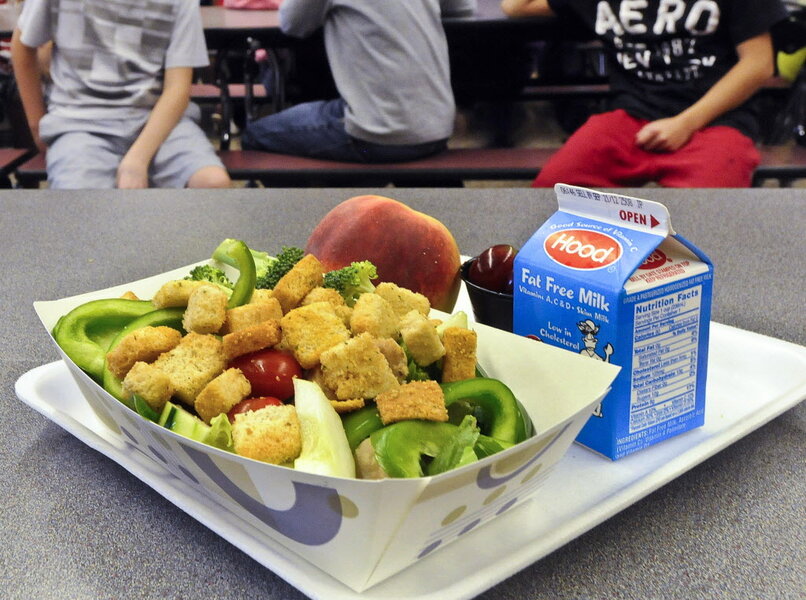Sixteen school lunch programs making a difference
Loading...
Over 31 million children in the United States consume most of their daily caloric intake at school. For many children, it may be the only food they eat regularly each day. But improving the quality of school lunches offers an effective way to ensure that half of what children eat is healthy, nutritious, and sustainably grown. School lunch programs that source organic, local, nutritious, and sustainable foods impact children’s health and also the health of our planet. Food Tank has compiled a list of 16 school lunch programs making strides to improve children’s health.
- The Baltimore Public School System, Baltimore, Maryland: The public school system in Baltimore was the first to adopt “Meatless Mondays,” which benefit students’ health as well as the environment. BCPS serves locally grown fruits, vegetables, and milk, and teaches its students how to grow their food at Great Kids Farm, a 33-acre teaching farm.
- The Berkeley Unified School District, Berkeley, California: The Berkeley Unified School District is committed to serving nutritious, delicious, and locally grown food to students. All processed foods, hydrogenated oils, high fructose corn syrup, refined sugars, refined flour, dyes, nitrates, additives, and chemicals are banned. Local, organic milk is served throughout cafeterias in addition to organic fruits and vegetables as much as possible.
- The Burlington School Food Project, Burlington, Vermont: The Burlington School Food Project provides free breakfast and dinner to 4,000 students in the Burlington School District. The project is dedicated to serving local food from farms in the area and was chosen as a model Farm to School program by the USDA in 2010.
- Farmhouse Café and Bakery, El Prado, New Mexico: The Farmhouse Café sponsors school garden projects, which serve over 450 meals a day at participating schools and teach children how to grow vegetables and make healthy food choices.
- The Finnish National Board of Education, Finland: Finland was the first country in the world to serve free school meals dating back to 1948. School meals are designed to support students’ health and to give them energy for their studies. Local fish, vegetables, fruit, and grains are featured on students’ plates to form tasty, colorful, balanced meals. Finnish law requires that half of the plate be filled with fresh and cooked vegetables.
- The French Ministry of National Education, France: School children in France are required to sit at the lunch table for at least a half an hour to eat a full meal. Fried food, foods high in fat, ketchup, and sweets are all limited. Meals are well-balanced and include vegetables, a warm main dish, cheese, and usually fruit for dessert. The government charges families on a sliding scale, which averages US$2.56–3.12.
- The Healthy Schools Campaign, Chicago, Illinois: Over 350,000 students in Chicago public schools eat healthier food thanks to the Healthy Schools Campaign. Produce is regionally grown, and chicken is raised without antibiotics in nearby Indiana.
- Italian Ministry of Education, University, and Research, Italy: Rome has an incredibly progressive school food program. About 150,000 meals are served daily at 740 public schools. Ninety-six percent of meals are made from scratch, and 70 percent of ingredients are organic. Much of the produce and meat is local or regional, and menus reflect the seasonality of crops grown in the region.
- The Good Earth School Lunch Program, Marin County, California: Over 4,000 children in twelve schools throughout Marin County participate in the healthy, organic, and nutritious Good Earth School Lunch Program.
- Kitchen Garden Project, United Kingdom: Celebrity chef Jamie Oliver launched the Kitchen Garden Project to teach primary school children in the U.K. how to grow, cook, and consume fresh and local produce. The Kitchen Garden Project believes that introducing children to fresh fruits and vegetables at a young age is crucial to developing life-long healthy eating habits.
- Ministry of Education, Culture, Sports, Science, and Technology, Japan: In Japan, school lunch is referred to as Shokuiku, which translates to food and nutrition education. The free school lunch program aims to promote mental and physical health and is based on government-established nutritional criteria. The program encourages sustainability by promoting environmentally friendly food production in local communities, encourages table manners, and celebrates the enjoyment of eating.
- Shelby County Nutrition Services, Tennessee: Over 110,000 students are served breakfast and lunch daily at Shelby County public schools, where Nutrition Services focuses on providing nutritious, healthy food to improve educational achievements. Nutrition Services are connected with the Farm to School Movement, which aims to serve healthy meals in school cafeterias, provide agriculture and nutrition education, improve student nutrition, and support local and regional farms.
- Ministry of Education South Korea: Over 800,000 school children in the public school system in Seoul receive hot, healthy lunches at school. The healthy and nutritious meal reflects Korean cuisine. Students are served protein, rice, kimchi (pickled vegetables), and other vegetables on the side.
- The Sitka “Fish to Schools” Program, Sitka, Alaska: The Sitka “Fish to Schools” Program aims to enhance students’ understanding of local seafood resources by including locally-caught seafood in the school lunch program. Students also receive education about the local fishing culture.
- Urban Sprouts, San Francisco, California: Since 2006, Urban Sprouts has partnered with schools throughout San Francisco to provide garden-based education in which students experience planting, growing, harvesting, and consuming crops directly from the school garden.
- Wellness in the Schools, New York, New York: Wellness in the Schools (WITS) encourages healthy eating, environmental awareness, and fitness as a way of life for public school kids in New York City. WITS forms partnerships with school leadership, teachers, chefs, coaches, parents, and kids, to develop and implement programs that provide nutritious foods, environments, and opportunities for kids to play, learn, and grow.
This article first appeared at Food Tank.





